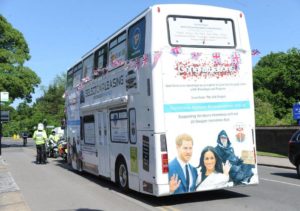This is SFIK the first royal wedding to feature buses. Oprah Winfrey, Serena Williams and the noisy cast of Suits took up the option of the bus transport to the Harry-Meghan extravaganza provided by Kensington Palace. (Buses are surely an important cultural and political reference to black Americans.) They must have saved quite a bit on taxis, as prices were no doubt gouged on the day.
 Meanwhile, the Thames Valley plod* impounded a bus used by an NGO to offer shelter to homeless people in Windsor. Can’t let sordid reality spoil the careful constructed image of multicultural bliss. I can’t find a photo of the guest buses, so the homeless one gets the RBC nod.
Meanwhile, the Thames Valley plod* impounded a bus used by an NGO to offer shelter to homeless people in Windsor. Can’t let sordid reality spoil the careful constructed image of multicultural bliss. I can’t find a photo of the guest buses, so the homeless one gets the RBC nod.
A-list celebrities are exquisitely sensitive to subtle shifts in style and taste. Is the humble proletarian bus making a social comeback?
 If it does, it will probably be on the back of electrification. Electric buses are much quieter and smoother than diesel ones, as well as non-polluting. The market is growing fast, led by China’s 100,000 a year (ca. 20% market share). Shenzhen, part of the Pearl River megalopolis and home to leading manufacturer BYD, already has a 16,000- strong all-electric fleet, a small part of which is pictured here.
If it does, it will probably be on the back of electrification. Electric buses are much quieter and smoother than diesel ones, as well as non-polluting. The market is growing fast, led by China’s 100,000 a year (ca. 20% market share). Shenzhen, part of the Pearl River megalopolis and home to leading manufacturer BYD, already has a 16,000- strong all-electric fleet, a small part of which is pictured here.
Cities and other bus operators outside China are beginning to place serious orders, after several years of messing about with small trials. London; Nottingham; Oslo; Hamburg; Los Angeles; Schiphol and LAX airports. That’s a very incomplete list, the bandwagon is rolling. San Francisco, promising an all-electric fleet by 2035 with first orders only in 2020, comes across as a greenwashing shilly-shallier.
The dramatic shift is driven by a combination of greenery and costs. Many city halls are now aware of the devastating health costs from urban air pollution, much of it from diesel vehicles, much of that from buses. On the cost side, thanks to sharp falls in the cost of batteries, electric buses are now competitive with diesels and CNG (natural gas) on a total-cost-of ownership basis (TCO). BNEF (link to pdf):
As battery prices continue to decline, e-buses will have a lower total cost of ownership than
comparable diesel or CNG buses for all of the options discussed here, even at lower annual
distances covered. Using the same battery price projections as in the upfront cost analysis, we estimate that the TCO for the most expensive e-bus configurations – the 350kWh e-bus coupled with slow charging at the depot and the 110kWh e-bus coupled with wireless charging – will reach TCO competitiveness with a diesel bus as soon as this year (2018).
Buses are just now as important as cars in the overall battery market (BNEF, page 21, Figure 10).
So for Hizzoner or Herroner at City Hall, and the rival politicians seeking to supplant them, buying electric buses is a free move. It gains green cred with voters, for real not phony reasons, and it doesn’t cost anything using sensible accounting. And the riders and drivers get more comfort and less vibration and noise.
* * * *
*Plod: Br.E. informal: a police officer; by extension (“the plod”), the police force. Probably from the character PC Plod in the successful Noddy children’s book series by Enid Blyton, 1950s.
Leave it to James Wimberley to find a smooth segway from a frivolous piece of entertainment to an important curent policy issue. Well done!
I'm flattered. Is your "segway" for "segue" a cupertino or a Freudian slip? A Segway is potentially a form of urban transport, not just a geek toy.
A Freudian slip, or, I suppose, a mere error. I meant 'segue', a transition. But, once again: with subtle policy implications!
We had electric buses in Baltimore when I was in high school in the late 1950s. There were no batteries back then that could carry a big enough charge to power them, so they ran off overhead electric lines, using trolleys following overhead lines. Thus, they were called "trackless trolleys."
They were buses, though, nothing like the trolley cars that were widespread in Baltimore at that time. The Trackless Trolleys had bus bodies, riding on bus tires, steered by bus drivers, pulling over to the curb to discharge and take on riders, and obliged to use turn signals just like other vehicles.
They didn't smell bad, they didn't pollute the air with black diesel smoke, they didn't spew invisible gases into the atmosphere, and they were altogether an excellent alternative to diesel buses.
Plus ca change, plus c'est la meme chose.
The aesthetic objection to both trams and trolleybuses is the cat's cradle of overhead wires. The operational objection is total inflexibility: the routes are where the wires are. The modern battery bus is clearly much superior. The range issue has been solved with either lots of batteries (as with BYD and Proterra, both offering over 150 miles on a single overnight charge) or en-route overhead fast chargers using inverted pantographs (preferred by Volvo). The only remaining case for the diesel bus is intercity routes, but even there the advantage won't last much longer.
"had"? in SF they're still running on many routes, both old/old/old ones (lemme tellya, they're OLD) and new/new/new ones too. And you're absolutely right about 'em — no smell, no grinding noise. And per JamesW below, yeah, some intersections the cat's cradle is pretty intense, up there.